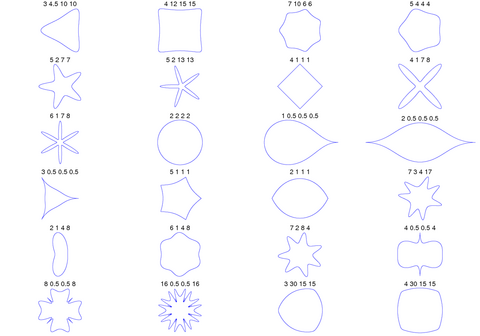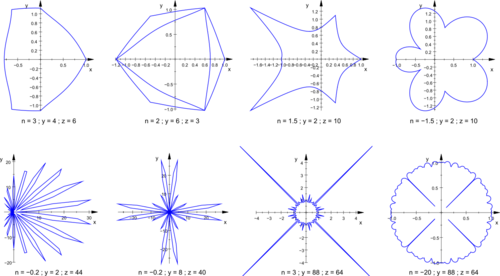Superformula
The superformula is a generalization of the superellipse and was proposed by Johan Gielis around 2000.[1] Gielis suggested that the formula can be used to describe many complex shapes and curves that are found in nature. Gielis has filed a patent application related to the synthesis of patterns generated by the superformula, which expired effective 2020-05-10.[2]
In polar coordinates, with [math]\displaystyle{ r }[/math] the radius and [math]\displaystyle{ \varphi }[/math] the angle, the superformula is:
[math]\displaystyle{ r\left(\varphi\right) = \left( \left| \frac{\cos\left(\frac{m\varphi}{4}\right)}{a} \right| ^{n_2} + \left| \frac{\sin\left(\frac{m\varphi}{4}\right)}{b} \right| ^{n_3} \right) ^{-\frac{1}{n_{1}}}. }[/math] By choosing different values for the parameters [math]\displaystyle{ a, b, m, n_1, n_2, }[/math] and [math]\displaystyle{ n_3, }[/math] different shapes can be generated.
The formula was obtained by generalizing the superellipse, named and popularized by Piet Hein, a Denmark mathematician.
2D plots
In the following examples the values shown above each figure should be m, n1, n2 and n3.
A GNU Octave program for generating these figures
function sf2d(n, a) u = [0:.001:2 * pi]; raux = abs(1 / a(1) .* abs(cos(n(1) * u / 4))) .^ n(3) + abs(1 / a(2) .* abs(sin(n(1) * u / 4))) .^ n(4); r = abs(raux) .^ (- 1 / n(2)); x = r .* cos(u); y = r .* sin(u); plot(x, y); end
Extension to higher dimensions
It is possible to extend the formula to 3, 4, or n dimensions, by means of the spherical product of superformulas. For example, the 3D parametric surface is obtained by multiplying two superformulas r1 and r2. The coordinates are defined by the relations:
[math]\displaystyle{ x = r_1(\theta)\cos\theta \cdot r_2(\phi)\cos\phi, }[/math] [math]\displaystyle{ y = r_1(\theta)\sin\theta \cdot r_2(\phi)\cos\phi, }[/math] [math]\displaystyle{ z = r_2(\phi)\sin\phi, }[/math]
where [math]\displaystyle{ \phi }[/math] (latitude) varies between −π/2 and π/2 and θ (longitude) between −π and π.
3D plots
3D superformula: a = b = 1; m, n1, n2 and n3 are shown in the pictures.
A GNU Octave program for generating these figures:
function sf3d(n, a)
u = [- pi:.05:pi];
v = [- pi / 2:.05:pi / 2];
nu = length(u);
nv = length(v);
for i = 1:nu
for j = 1:nv
raux1 = abs(1 / a(1) * abs(cos(n(1) .* u(i) / 4))) .^ n(3) + abs(1 / a(2) * abs(sin(n(1) * u(i) / 4))) .^ n(4);
r1 = abs(raux1) .^ (- 1 / n(2));
raux2 = abs(1 / a(1) * abs(cos(n(1) * v(j) / 4))) .^ n(3) + abs(1 / a(2) * abs(sin(n(1) * v(j) / 4))) .^ n(4);
r2 = abs(raux2) .^ (- 1 / n(2));
x(i, j) = r1 * cos(u(i)) * r2 * cos(v(j));
y(i, j) = r1 * sin(u(i)) * r2 * cos(v(j));
z(i, j) = r2 * sin(v(j));
endfor;
endfor;
mesh(x, y, z);
endfunction;
Generalization
The superformula can be generalized by allowing distinct m parameters in the two terms of the superformula. By replacing the first parameter [math]\displaystyle{ m }[/math] with y and second parameter [math]\displaystyle{ m }[/math] with z:[3] [math]\displaystyle{ r\left(\varphi\right) = \left( \left| \frac{\cos\left(\frac{y\varphi}{4}\right)}{a} \right| ^{n_2} + \left| \frac{\sin\left(\frac{z\varphi}{4}\right)}{b} \right| ^{n_3} \right) ^{-\frac{1}{n_{1}}} }[/math]
This allows the creation of rotationally asymmetric and nested structures. In the following examples a, b, [math]\displaystyle{ {n_2} }[/math] and [math]\displaystyle{ {n_3} }[/math] are 1:
References
- ↑ Gielis, Johan (2003), "A generic geometric transformation that unifies a wide range of natural and abstract shapes", American Journal of Botany 90 (3): 333–338, doi:10.3732/ajb.90.3.333, ISSN 0002-9122, PMID 21659124, https://bsapubs.onlinelibrary.wiley.com/doi/10.3732/ajb.90.3.333

- ↑ "Method and apparatus for synthesizing patterns" EP patent 1177529, issued 2005-02-02
- ↑ * Stöhr, Uwe (2004), SuperformulaU, http://ftp.lyx.de/Lectures/SuperformulaU.pdf
External links
- Some Experiments on Fitting of Gielis Curves by Simulated Annealing and Particle Swarm Methods of Global Optimization
- Least Squares Fitting of Chacón-Gielis Curves By the Particle Swarm Method of Optimization
- Superformula 2D Plotter & SVG Generator
- Interactive example using JSXGraph
- SuperShaper: An OpenSource, OpenCL accelerated, interactive 3D SuperShape generator with shader based visualisation (OpenGL3)
- Simpel, WebGL based SuperShape implementation
 |











